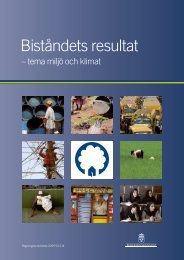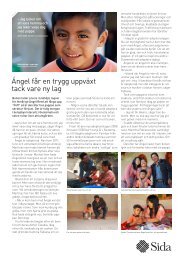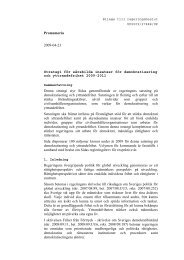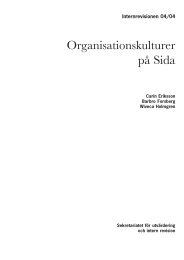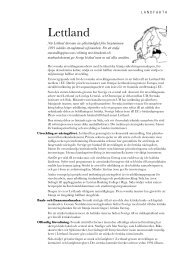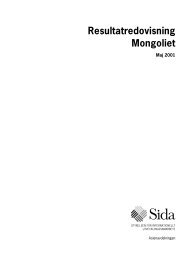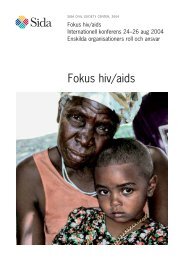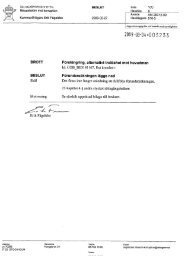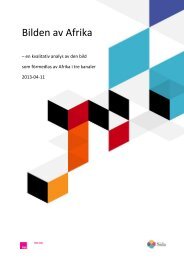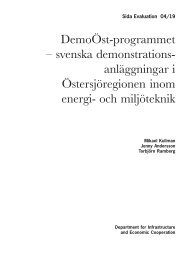Mobilisation of the Poor – a means to Poverty Reduction? - Sida
Mobilisation of the Poor – a means to Poverty Reduction? - Sida
Mobilisation of the Poor – a means to Poverty Reduction? - Sida
Create successful ePaper yourself
Turn your PDF publications into a flip-book with our unique Google optimized e-Paper software.
Judging by <strong>the</strong> responses <strong>of</strong> <strong>the</strong> households in <strong>the</strong> sample, <strong>the</strong> gross household savings in CAP<br />
organisations were higher than <strong>the</strong> combined household savings in Samurdhi, Sarvodaya,<br />
SANASA and Seettu, indicating that <strong>the</strong> CAP member households were inclined <strong>to</strong> save more<br />
money in CAP organisations despite <strong>the</strong> availability <strong>of</strong> o<strong>the</strong>r options. While <strong>the</strong> longer duration <strong>of</strong><br />
CAP activities compared <strong>to</strong> <strong>the</strong> Samurdhi programme in many <strong>of</strong> <strong>the</strong> study areas may be a fac<strong>to</strong>r<br />
in <strong>the</strong> higher volume <strong>of</strong> household saving in CAP organisations, we must bear in mind that it is<br />
manda<strong>to</strong>ry for Samurdhi beneficiaries <strong>to</strong> save a prescribed amount. Given <strong>the</strong> more voluntary<br />
nature <strong>of</strong> household saving in CAP, <strong>the</strong> reported pattern <strong>of</strong> saving may be unders<strong>to</strong>od as an index<br />
<strong>of</strong> greater household confidence in CAP small groups, despite <strong>the</strong>ir informal character.<br />
Of <strong>the</strong> 139 households who claimed <strong>to</strong> be currently active in CAP, only 5 per cent had joined <strong>the</strong><br />
programme before 1991, 33 per cent had joined between 1991 and 1995, and <strong>the</strong> remaining 62 per<br />
cent had joined <strong>the</strong> programme after 1995 (see Table 7). This in turn indicated that <strong>the</strong> vast<br />
majority <strong>of</strong> CAP participants had less than seven years <strong>of</strong> contact with <strong>the</strong> programme.<br />
In order <strong>to</strong> fur<strong>the</strong>r examine <strong>the</strong> relative significance <strong>of</strong> CAP with regard <strong>to</strong> <strong>the</strong> countrywide<br />
programme <strong>of</strong> Samurdhi, we compared household participation in <strong>the</strong> two programmes in several<br />
ways. On <strong>the</strong> whole <strong>the</strong> percentage <strong>of</strong> households that claimed <strong>to</strong> be actively involved in <strong>the</strong><br />
Samurdhi programme was 62 per cent, compared <strong>to</strong> 38 per cent in CAP. Nearly 35 per cent <strong>of</strong><br />
households that are active in CAP, and a similar percentage <strong>of</strong> households that are active in<br />
Samurdhi, said that <strong>the</strong>y have had no connection with <strong>the</strong> o<strong>the</strong>r programme. This shows that while<br />
<strong>the</strong>re may be some overlap in <strong>the</strong> groups served by <strong>the</strong> two programmes, <strong>the</strong>y are by no <strong>means</strong><br />
identical. While 64 per cent <strong>of</strong> those active in CAP were also active in Samurdhi, <strong>of</strong> those active in<br />
Samurdhi only 39 per cent were active in CAP (see Table 10). This clearly shows that despite <strong>of</strong> <strong>the</strong><br />
over-sampling <strong>of</strong> CAP households, Samurdhi affiliation remains more widespread in <strong>the</strong> sample. It<br />
also reveals that <strong>the</strong>re are many households in <strong>the</strong> study areas that are affiliated with both<br />
programmes. Finally, <strong>of</strong> <strong>the</strong> 78 households that reportedly dropped out <strong>of</strong> <strong>the</strong> CAP programme, 64<br />
per cent were found <strong>to</strong> be currently active in <strong>the</strong> Samurdhi programme, indicating that <strong>the</strong>y moved<br />
from CAP <strong>to</strong> Samurdhi. This confirms <strong>the</strong> point that where CAP is effective, households remain<br />
affiliated with both programmes, but once CAP becomes weaker or ineffective, <strong>the</strong>y tend <strong>to</strong> drop<br />
out <strong>of</strong> CAP and opt for <strong>the</strong> <strong>of</strong>ficial and, <strong>the</strong>refore, centrally administered, poverty alleviation<br />
programme <strong>of</strong> <strong>the</strong> state as <strong>the</strong>ir primary institutional affiliation.<br />
In conclusion, <strong>the</strong> data presented in this chapter reveals that as a grassroots level programme CAP<br />
has had considerable success in sustaining a critical mass <strong>of</strong> enthusiasts, demonstrating evidence <strong>of</strong><br />
<strong>the</strong> viability and effectiveness <strong>of</strong> social mobilisation for nearly a quarter <strong>of</strong> a century, surviving<br />
many changes in personnel, management systems, donors and political regimes, and exhibiting an<br />
unusual degree <strong>of</strong> resilience in adapting <strong>to</strong> new situations and capturing <strong>the</strong> imagination and<br />
enthusiasm <strong>of</strong> many rural women and men in various parts <strong>of</strong> Sri Lanka. On <strong>the</strong> negative side, <strong>the</strong><br />
effectiveness <strong>of</strong> <strong>the</strong> programme has been adversely affected by a range <strong>of</strong> fac<strong>to</strong>rs, including decline<br />
<strong>of</strong> membership, rapid turnover <strong>of</strong> mobilisers, <strong>the</strong> weakening <strong>of</strong> small group processes in some areas,<br />
<strong>the</strong> weakening <strong>of</strong> social mobilisation itself under <strong>the</strong> pressure <strong>of</strong> micro-finance/income-generating<br />
activities, instances <strong>of</strong> mismanagement and misappropriation <strong>of</strong> group funds, and <strong>the</strong> increased<br />
tendency among CAP members <strong>to</strong> expect handouts, particularly supply <strong>of</strong> credit. A balanced<br />
evaluation <strong>of</strong> <strong>the</strong> programme makes it necessary for us <strong>to</strong> carefully assess both positive and negative<br />
aspects <strong>of</strong> <strong>the</strong> programme.<br />
28<br />
MOBILISATION OF THE POOR <strong>–</strong> A MEANS TO POVERTY REDUCTION <strong>–</strong> <strong>Sida</strong> EVALUATION 02/08




